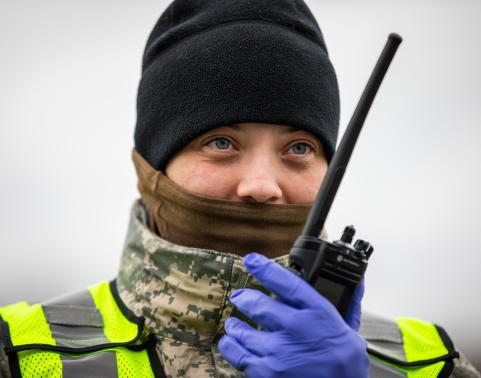PM DCATS Supports the Army’s Preparations for Pandemics

The President has called upon the Army to help in the effort to control the spread of the coronavirus, and Soldiers and Army Leaders depend on the Army network as its fundamental weapon system to respond.
The project manager for Defense Communications and Army Transmission Systems (PM DCATS)' Land Mobile Radio (LMR) provides network services that support the Department of Defense, Department of Homeland Security, and the Joint Task Force Civil Support.
Acting Product Lead LMR EJ Wasikowski: “LMR is employed by the Army and other services, along with local, state, and federal agencies, for collaboration during normal, crisis, and recovery operations resulting from intentional attacks, accidental occurrences and natural disasters such as hurricanes or floods; the same is true during a pandemic."
Army installations employ multiple LMR systems, to include Base Emergency Communications Systems (BECS): Computer-Aided Dispatch (CAD); Enterprise 911(E911)/Next Generation 911(NG911); Land Mobile Radio (LMR), Enterprise Mass Warning and Notification (EMWN) and the FirstNet.
Part of the LMR product suite, “public safety voice LMR networks today are among the most reliable networks available in the United States and bring an assured voice capability to first responders for dependable critical communications that help save lives,” says Wasikowski.
Through enhanced integration, coordination, shared information, knowledge, and teamwork among U.S. multi-jurisdictional and multi-national agencies, LMR assists in detecting, deterring and preventing threats. In this case, it is proving invaluable in pandemic response.
"Post/camps/stations are at various stages of modernization," explains Project Manager DCATS Col. Enrique Costas. "Installations that have been accredited with the newer systems from Motorola and Harris Corporation will be enabled to ensure that they have assured voice communications, and that their computer-aided dispatch has the ability to more accurately track the incident and the data.”
LMR is also piloting FirstNet authority from AT&T, which is a Department of Commerce contract to augment the first responders' network at Fort Hood. Says Costas, "This is a prime example in which all the capabilities that enable first responders to have public safety communications will be tested to see how resilient they are." Meanwhile, the demand signal for assured voice and information is exponentially growing. "This first deployment will allow us to see what other improvements are needed."
LMR networks have a long history of fulfilling the requirements of public safety communications for Army installations. With the current challenge, LMR is adding public carrier broadband networks alongside LMR networks.
Says Wasikowski, "Each of the networks fulfills a different need -- LMR provides mission-critical assured voice communications, while broadband networks provide a large pipe that enables a range of data-intensive applications to be run. The use of LMR and FirstNet in conjunction provides greater coverage and redundancy than just using one network alone.”
Related News
-
Jason Morneault assumes command of Wideband Enterprise Satellite Systems
August 22, 2023On June 30, Project Manager Integrated Enterprise Network (IEN) conducted an assumption of charter ceremony for the Wideband Enterprise Satellite Systems (WESS) Product Management Office. -
Joe David values determination, hands-off leadership and family
June 27, 2023“You must want it mentally and you must show it physically, giving it your all.”
As an aspiring high school football player, Joe David received this advice from his father.
-
Darius White Explains the Power of Storytelling
April 26, 2023“Storytelling is a way to connect with people, even if it is fanciful or scientific, on another level,” said Darius White.
Work for Us
Join a winning team! Search for job opportunities with PEO Enterprise.
Work with Us
Help support important missions. Explore ways your company can work with PEO Enterprise.